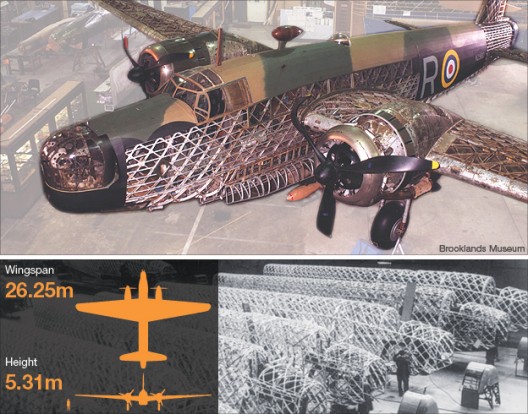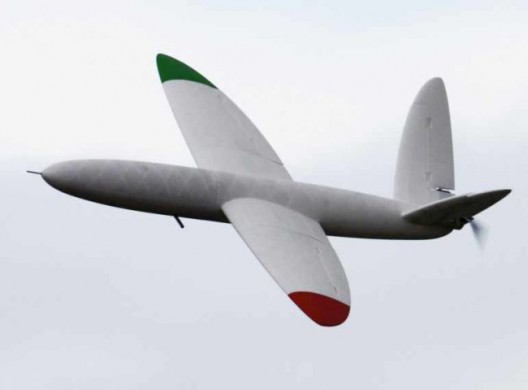Students and faculty at the University of Southampton on the southern English coast have created an unmanned aerial vehicle (UAV) in just a week, from the initial design to the finished, flying object.
“Printed” from nylon on an EOS EOSINT P730 nylon laser sintering machine, the plane emerges from the device in successive layers and comes with hinges already in place, emulating the bearings, crank and headset-in-place bicycle recently produced by EADS (Airbus) using similar technology and materials.
http://www.youtube.com/watch?v=aFFFiB_if18
Part of a “ground-breaking” course of study “which enables students to take a Master’s Degree in unmanned autonomous vehicle (UAV) design,” the Southampton University Layer Sintered Aircraft (SULSA) can be snap-fitted together in minutes without tools.
SULSA has a 2-meter (6.4 feet) wingspan and an electric motor reputed to be “almost silent” in cruise mode (but not so much in launch mode as the video reveals). It is steadied by a “miniature autopilot developed by Dr. Matt Bennett, one of the members of the team.”
According to the University, “This project has been led by Professors Andy Keane and Jim Scanlan from the University’s Computational Engineering and Design Research group.
“Professor Scanlon says: ‘The flexibility of the laser sintering process allows the design team to re-visit historical techniques and ideas that would have been prohibitively expensive using conventional manufacturing. One of these ideas involves the use of a Geodetic structure. This type of structure was initially developed by Barnes Wallis and famously used on the Vickers Wellington bomber which first flew in 1936. This form of structure is very stiff and lightweight, but very complex. If it was manufactured conventionally it would require a large number of individually tailored parts that would have to be bonded or fastened at great expense.’
“Professor Keane adds: ‘Another design benefit that laser sintering provides is the use of an elliptical wing planform. Aerodynamicists have, for decades, known that elliptical wings offer drag benefits. The Spitfire wing was recognized as an extremely efficient design but it was notoriously difficult and expensive to manufacture. Again laser sintering removes the manufacturing constraint associated with shape complexity and in the SULSA aircraft there is no cost penalty in using an elliptical shape.’”
SULSA is an early effort for postgraduate students who, beginning in September 2011, can “take part in a one year program covering the design, manufacture and operation of robotic vehicles.” Such vehicles whether land, marine, or aerial, would be used in hostile environments or in areas where human involvement might be unsafe or “uneconomic.”
New Scientist points out that traditional techniques tie a design to repeated manufacture on production lines.
Consider the Wellington example. The industrial engineer who designed the extremely complex manufacturing process for the airplane received a knighthood. All parts manufactured in centralized stamping facilities had to be numbered like a giant erector set, be totally interchangeable and shipped to diverse factories all over England, where the “kits”could be marshaled and bolted and riveted together by relatively unskilled workers. In service, the level of interchangeability was near perfect, and any part made in any factory could be matched to components made in any other factory. An amazing 11,000 Wellingtons were produced this way.
Further consider modern composite construction, which requires highly accurate molds that cannot be modified or “improved upon” during a production run without great expense.
“No longer,” its creators told New Scientist, “will one design of UAV (Editor’s Note: or, by inference, any airplane) be repeatedly manufactured on a production line. Instead, designers will be able to fine-tune a UAV for each specific application – whether it be crop spraying, surveillance or infrared photography – and then print a bespoke plane on demand.”
Perhaps, as part of the demonstration of laser printing’s capabilities, SULSA has the complex geodetic structure the Wellington and the aerodynamically pure but complex wing of the Spitfire in its makeup. “With 3D printing we can go back to pure forms and explore the mathematics of airflow without being forced to put in straight lines to keep costs down,” Keane told the magazine.
Working with a 5,000 pound ($8,000) budget and 3D printing firm 3T RPD, the Southampton team determined that the plane would have no landing gear, necessitating a catapult launch, and therefore make a belly landing. It has an electric motor, doing away with fuel and starting equipment, and a V-tail to reduce parts count. Despite the simplicity and cost constraints, the airplane does achieve 100 miles per hour.
Time was economically used, too, with just two days in design and five days in printing. Scanlan noted that variants of the design could be created in minutes using automated design software.
During the test flights, Scanlan marveled, “It’s very hard to believe this aircraft was just a pile of dust last Friday.”
The CAFE Foundation will have rapid prototyping machines on display during Green Flight Challenge closing ceremonies at NASA Ames Research Center at Moffett Field, California on October 3, 2011.


